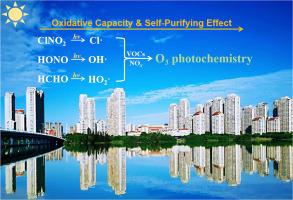The primary sources of ROx radicals in atmosphere: Oxidative capacity and self-purifying effect
IF 6.3
2区 环境科学与生态学
Q1 ENVIRONMENTAL SCIENCES
引用次数: 0
Abstract
Ambient ozone (O3) is generated through the reactions of nitrogen oxides and volatile organic compounds (VOCs) in sunlight, and the primary sources of ROx radicals play a very important role in O3 photochemistry. However, as major precursors of ROx radicals, the systematical evaluation of ClNO2, HCHO, and HONO impacts on O3 photochemistry remains limited. Here, we utilized the observations of ClNO2, HCHO, and HONO conducted in a coastal city of Southeast China during a photochemical O3 pollution episode, combined with model simulations to elucidate their impacts on ROx radicals and atmospheric oxidation capacity (AOC), as well as O3 formation. Decreased concentrations of ClNO2 and HONO were observed after sunrise, while HCHO concentrations peaked in the daytime. HCHO photolysis contributed the largest (∼25 %) to ROx radical production around noon, while HONO photolysis (∼47 %) dominated ROx radical production in the morning and late afternoon, and VOCs consumed by Cl radical released via ClNO2 photolysis was more important (∼10 %) in the early morning, similar to their effects on the AOC levels. The results of model simulations indicated that HCHO photolysis greatly enhanced the photochemical formation of O3, followed by HONO and ClNO2 photolysis. Except for reducing VOCs due to a VOC-limited regime, the impacts of HCHO photolysis as primary ROx sources should be valued to inhibit the intensification of O3 pollution. Our study stressed the importance of primary ROx sources for O3 photochemistry in coastal regions, provided new insights into elucidating the self-purifying effect of the atmospheric environment.

大气中氧自由基的主要来源:氧化能力和自净作用
环境臭氧(O3)是由氮氧化物和挥发性有机物(VOCs)在阳光下反应生成的,而ROx自由基的主要来源在O3光化学中起着非常重要的作用。然而,作为ROx自由基的主要前体,ClNO2、HCHO和HONO对O3光化学影响的系统评价仍然有限。本文利用光化学O3污染期间在中国东南沿海城市进行的ClNO2、HCHO和HONO观测,并结合模式模拟来阐明它们对ROx自由基、大气氧化能力(AOC)以及O3形成的影响。ClNO2和HONO浓度在日出后下降,而HCHO浓度在白天达到峰值。中午前后,HCHO光解作用对ROx自由基的产生贡献最大(~ 25%),而HONO光解作用(~ 47%)在上午和下午晚些时候主导了ROx自由基的产生,通过ClNO2光解释放的Cl自由基消耗的VOCs在清晨更重要(~ 10%),这与它们对AOC水平的影响相似。模型模拟结果表明,HCHO光解作用显著促进O3的光化学生成,其次是HONO和ClNO2光解作用。除了由于VOCs限制制度而减少VOCs外,应重视HCHO光解作为主要ROx源的影响,以抑制O3污染的加剧。我们的研究强调了主要ROx源对沿海地区O3光化学的重要性,为阐明大气环境的自净化作用提供了新的见解。
本文章由计算机程序翻译,如有差异,请以英文原文为准。
求助全文
约1分钟内获得全文
求助全文
来源期刊

Journal of Environmental Sciences-china
环境科学-环境科学
CiteScore
13.70
自引率
0.00%
发文量
6354
审稿时长
2.6 months
期刊介绍:
The Journal of Environmental Sciences is an international journal started in 1989. The journal is devoted to publish original, peer-reviewed research papers on main aspects of environmental sciences, such as environmental chemistry, environmental biology, ecology, geosciences and environmental physics. Appropriate subjects include basic and applied research on atmospheric, terrestrial and aquatic environments, pollution control and abatement technology, conservation of natural resources, environmental health and toxicology. Announcements of international environmental science meetings and other recent information are also included.
 求助内容:
求助内容: 应助结果提醒方式:
应助结果提醒方式:


